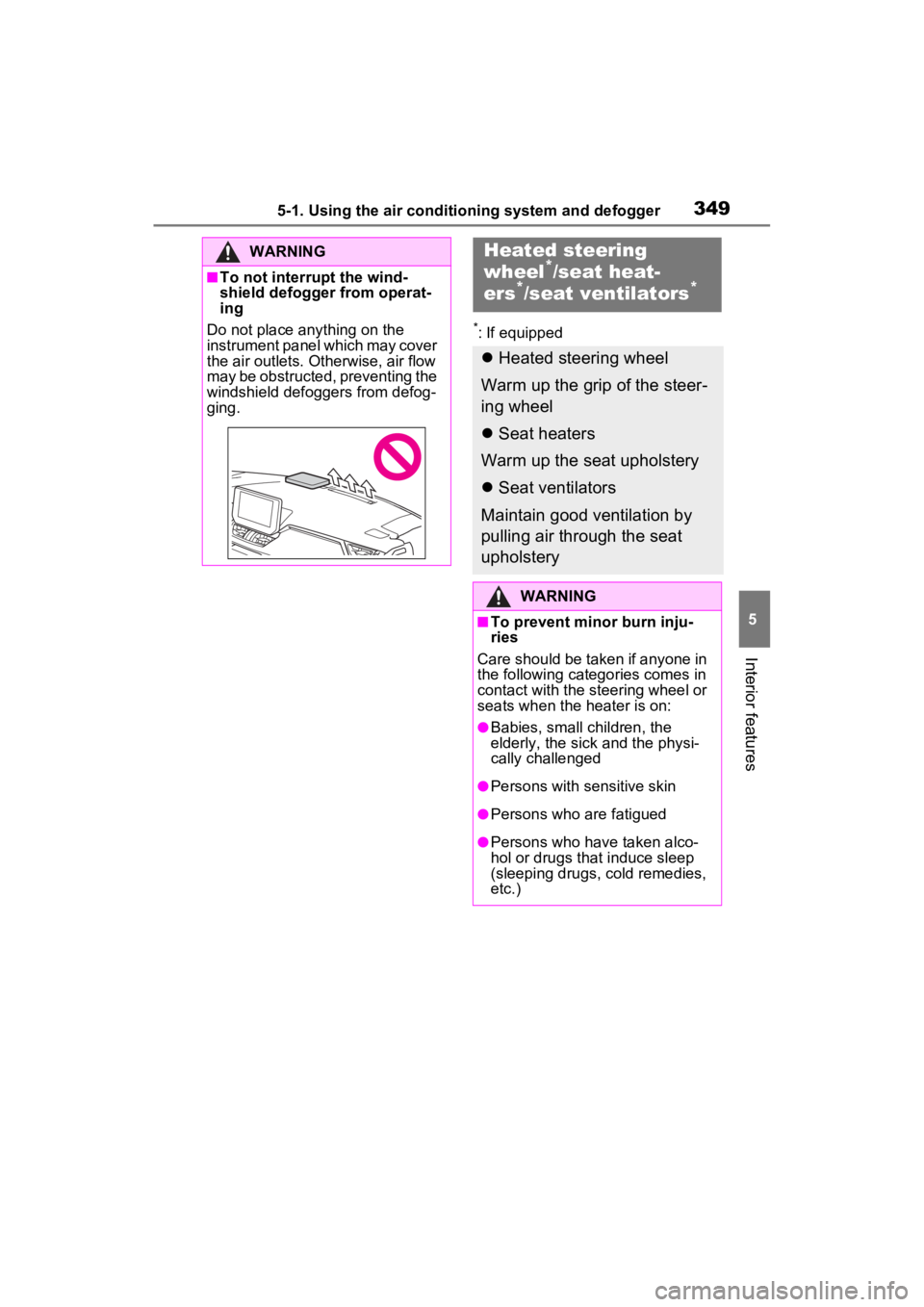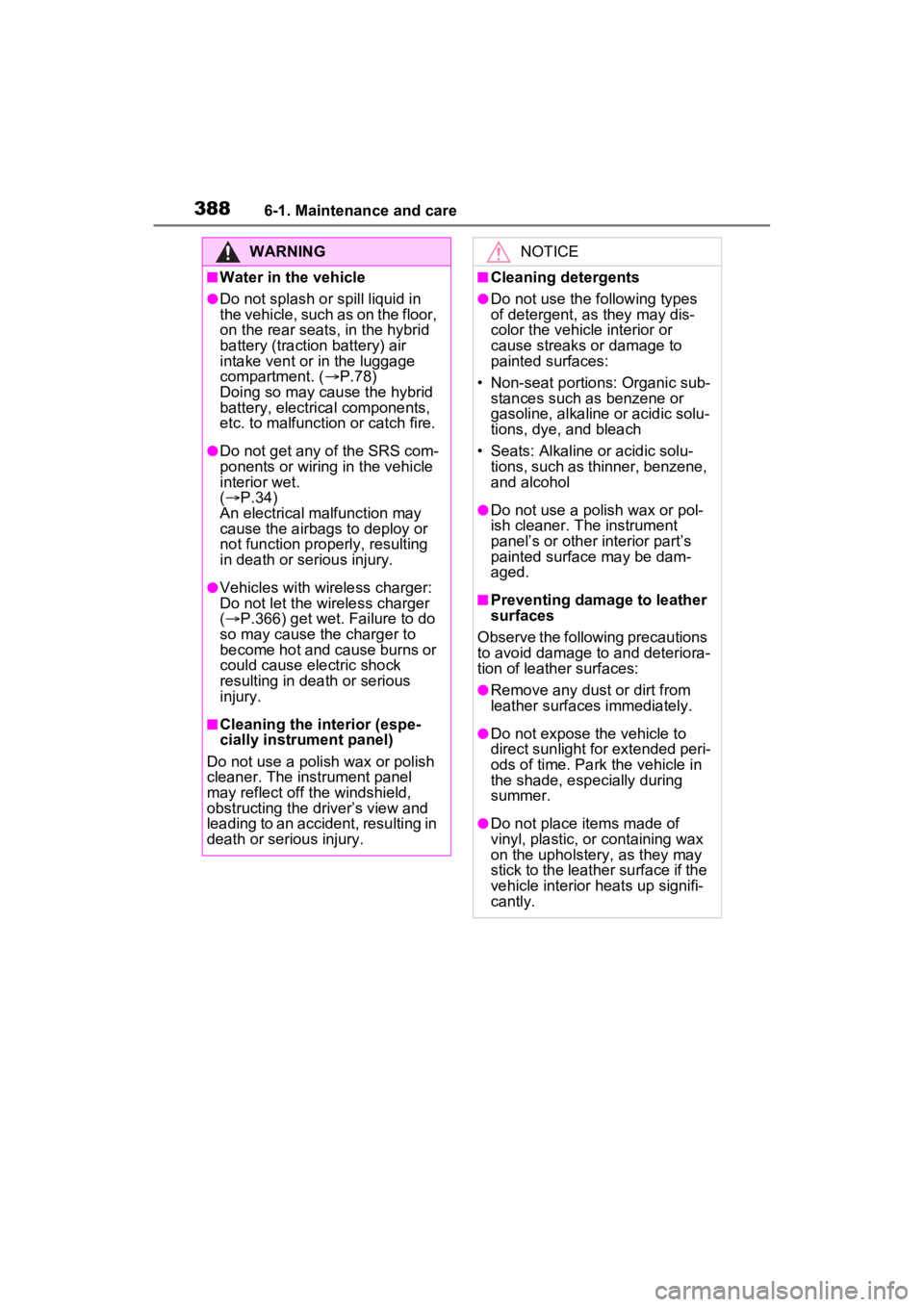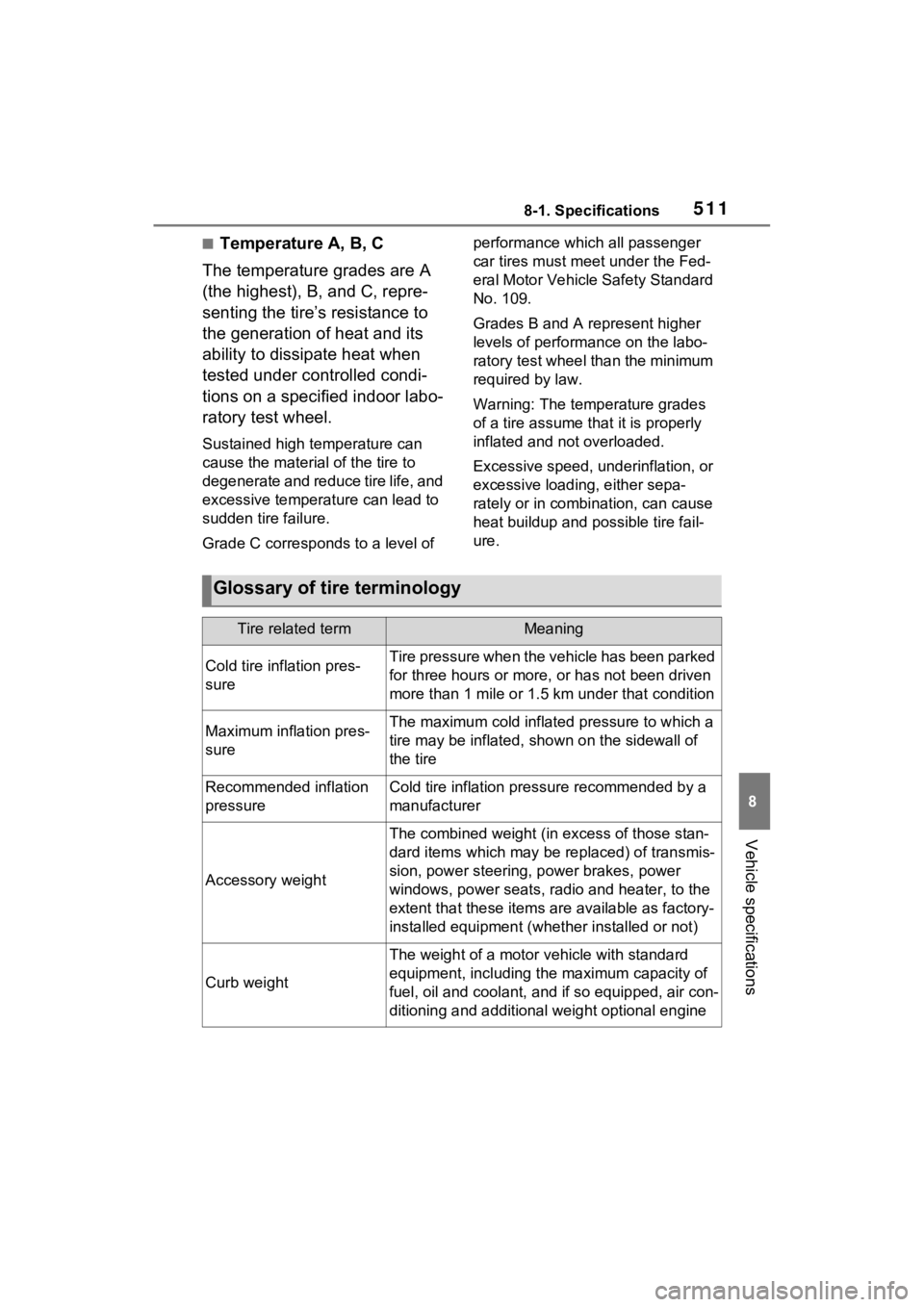2023 TOYOTA RAV4 HYBRID seats
[x] Cancel search: seatsPage 349 of 586

3475-1. Using the air conditioning system and defogger
5
Interior features
This function automatically con-
trols the air conditioning airflow
so that priority is given to the
front seats. When the front pas-
senger seat is not occupied, air-
flow may switch to only the
driver’s seat. Unnecessary air
conditioning is suppressed, con-
tributing to increased fuel effi-
ciency.
Front seat concentrated airflow
mode operates in the following
situations.
No passengers are detected
in the rear seats
The windshield defogger is
not operating
While operating, illumi-
nates.
■Manually turning front seat
concentrated airflow mode
on/off
In front seat concentrated air-
flow mode, directing airflow to
the front seats only and to all
seats can be switched via switch
operation. When the mode has
been switched manually, auto-
matic airflow control stops oper-
ating.
Press on the air condition-
ing operation panel and switch
the airflow.
Indicator illuminated: Airflow
to the front seats only
Indicator off: Airflow to all the
seats
■Operation of automatic airflow
control
●In order to maintain a comfortable
interior, airflow may be directed to
seats without passengers immedi-
ately after the hybrid system is
started and at other times depend-
ing on the outside temperature.
●After the hybrid system is started,
if passengers move around inside
or enter/exit the vehicle, the sys-
tem cannot accura tely detect the
presence of passengers and auto-
matic airflow co ntrol will not oper-
ate.
■Operation of manual airflow
control
Even if the funct ion is manually
switched to directing airflow to only
the front seats, w hen a rear seat is
occupied, it may automatically direct
airflow to all seats.
■To return to automatic airflow
control
1 With the indicator off, turn the
power switch to OFF.
2 After 60 minutes or more elapse,
turn the power switch to ON.
This feature is used to prevent
ice from building up on the wind-
shield and wiper blades.
Press the switch to turn the sys-
tem on/off.
The indicator comes on when the
system is on.
Front seat concentrated
airflow mode (S-FLOW)
Windshield wiper de-icer
(if equipped)
Page 351 of 586

3495-1. Using the air conditioning system and defogger
5
Interior features
*: If equipped
WARNING
■To not interrupt the wind-
shield defogger from operat-
ing
Do not place anything on the
instrument panel which may cover
the air outlets. Otherwise, air flow
may be obstructed, preventing the
windshield defoggers from defog-
ging.
Heated steering
wheel*/seat heat-
ers*/seat ventilators*
Heated steering wheel
Warm up the grip of the steer-
ing wheel
Seat heaters
Warm up the seat upholstery
Seat ventilators
Maintain good ventilation by
pulling air through the seat
upholstery
WARNING
■To prevent minor burn inju-
ries
Care should be taken if anyone in
the following categories comes in
contact with the steering wheel or
seats when the heater is on:
●Babies, small children, the
elderly, the sick and the physi-
cally challenged
●Persons with sensitive skin
●Persons who are fatigued
●Persons who have taken alco-
hol or drugs that induce sleep
(sleeping drugs, cold remedies,
etc.)
Page 390 of 586

3886-1. Maintenance and care
WARNING
■Water in the vehicle
●Do not splash or spill liquid in
the vehicle, such as on the floor,
on the rear seats, in the hybrid
battery (traction battery) air
intake vent or in the luggage
compartment. (P.78)
Doing so may cause the hybrid
battery, electrical components,
etc. to malfunction or catch fire.
●Do not get any of the SRS com-
ponents or wiring in the vehicle
interior wet.
( P.34)
An electrical malfunction may
cause the airbags to deploy or
not function properly, resulting
in death or serious injury.
●Vehicles with wireless charger:
Do not let the wireless charger
( P.366) get wet. Failure to do
so may cause the charger to
become hot and cause burns or
could cause electric shock
resulting in death or serious
injury.
■Cleaning the interior (espe-
cially instrument panel)
Do not use a polis h wax or polish
cleaner. The instrument panel
may reflect off the windshield,
obstructing the dr iver’s view and
leading to an accident, resulting in
death or serious injury.
NOTICE
■Cleaning detergents
●Do not use the following types
of detergent, as they may dis-
color the vehicle interior or
cause streaks or damage to
painted surfaces:
• Non-seat portions: Organic sub- stances such as benzene or
gasoline, alkaline or acidic solu-
tions, dye, and bleach
• Seats: Alkaline or acidic solu- tions, such as thinner, benzene,
and alcohol
●Do not use a polish wax or pol-
ish cleaner. The instrument
panel’s or other interior part’s
painted surface may be dam-
aged.
■Preventing damage to leather
surfaces
Observe the following precautions
to avoid damage to and deteriora-
tion of leather surfaces:
●Remove any dust or dirt from
leather surfaces immediately.
●Do not expose the vehicle to
direct sunlight for extended peri-
ods of time. Park the vehicle in
the shade, especially during
summer.
●Do not place items made of
vinyl, plastic, or containing wax
on the upholstery, as they may
stick to the leather surface if the
vehicle interior heats up signifi-
cantly.
Page 395 of 586

3936-2. Maintenance
6
Maintenance and care
Brake pedal
• Does the brake pedal move
smoothly?
• Does the brake pedal have
appropriate
clearance from
the floor?
• Does the brake pedal have the
correct amount
of free play?
Brakes
• The vehicle should not pull to
one side when
the brakes are
applied.
• The brakes should work
effectively.
• The brake pedal should not feel
spongy.
• The brake pedal should not get
too close to the
floor when the
brakes are
applied.
Head
restraints
• Do the head restraints move
smoothly and
lock securely?
Indica-
tors/buzzers
• Do the indica-tors and buzzers
function prop-
erly?
ItemsCheck points
Lights
• Do all the lights come on?
• Are the head- lights aimed cor-
rectly?
Parking brake
• Does the park-ing brake oper-
ate normally?
• When parked on a slope and the
parking brake is
on, is the vehicle
securely
stopped?
Seat belts
• Do the seat belts operate
smoothly?
• The seat belts should not be
damaged.
Seats
• Do the seat con-trols operate
properly?
Steering wheel
• Does the steer-ing wheel rotate
smoothly?
• Does the steer- ing wheel have
the correct
amount of free
play?
• There should not be any strange
sounds coming
from the steer-
ing wheel.
ItemsCheck points
Page 513 of 586

5118-1. Specifications
8
Vehicle specifications
■Temperature A, B, C
The temperature grades are A
(the highest), B, and C, repre-
senting the tire’s resistance to
the generation of heat and its
ability to dissipate heat when
tested under controlled condi-
tions on a specified indoor labo-
ratory test wheel.
Sustained high temperature can
cause the material of the tire to
degenerate and reduce tire life, and
excessive temperature can lead to
sudden tire failure.
Grade C corresponds to a level of performance which all passenger
car tires must meet under the Fed-
eral Motor Vehicle Safety Standard
No. 109.
Grades B and A represent higher
levels of performance on the labo-
ratory test wheel than the minimum
required by law.
Warning: The temperature grades
of a tire assume tha
t it is properly
inflated and not overloaded.
Excessive speed, underinflation, or
excessive loading, either sepa-
rately or in combination, can cause
heat buildup and possible tire fail-
ure.
Glossary of tire terminology
Tire related termMeaning
Cold tire inflation pres-
sureTire pressure when the vehicle has been parked
for three hours or more, or has not been driven
more than 1 mile or 1.5 km under that condition
Maximum inflation pres-
sureThe maximum cold inflated pressure to which a
tire may be inflated, shown on the sidewall of
the tire
Recommended inflation
pressureCold tire inflation pressure recommended by a
manufacturer
Accessory weight
The combined weight (in excess of those stan-
dard items which may be replaced) of transmis-
sion, power steering, power brakes, power
windows, power seats, radio and heater, to the
extent that these items are available as factory-
installed equipment (whether installed or not)
Curb weight
The weight of a motor vehicle with standard
equipment, including th e maximum capacity of
fuel, oil and coolant, and if so equipped, air con-
ditioning and additional weight optional engine
Page 557 of 586

Alphabetical Index555
EV indicator .............................. 71
Exhaust gas precautions ......... 48
F
Flat tire .................................... 471Tire pressure warning system........................................... 412
Floor mats ................................. 26
Fluid Brake ............................ 405, 501
Hybrid transmission.............. 501
Rear differential .................... 501
Washer ................................. 406
Fog lights Replacing light bulbs ............ 439
Switch................................... 244
Footwell lights ..... ................... 352
Front passenger’s seat belt reminder light ....................... 462
Front passenger occupant clas- sification system .................... 43
Front position lights Light switch .......................... 237
Front seat heaters .................. 349
Front seats .............................. 160 Adjustment ........................... 160
Cleaning ............................... 387
Correct driving posture ........... 27
Driving position memory....... 163
Head restraints ..................... 166
Memory recall function ......... 165
Seat heaters ......................... 349
Seat position memory .......... 163
Seat ventilators .................... 349
Front side marker lights ........ 237 Light switch .......................... 237
Replacing light bulbs ............ 439
Wattage ................................ 504
Front turn signal lights Replacing light bulbs ............ 439
Turn signal lever................... 230
Wattage ................................ 504 Fuel
Capacity ...............................497
Fuel gauge .......................93, 99
Gas station information ........584
Information ......... ..................505
Refueling ..............................249
Type .............................497, 505
Warning light ........................462
Fuel filler door.........................250 If the fuel filler door cannot be opened ...............................482
Refueling ..............................249
Fuel gauge...........................93, 99
Fuses .......................................436
G
Garage door opene r ...............375
Gas station information .........584
Gauges ................................93, 99
Glove box ................................356
H
Headlight aim ..........................438 Headlight aim instructions for Canadian owners ...............544
Headlights ...............................237 Automatic High Beam system...........................................240
Light switch...........................237
Replacing light bulbs ............439
Head restraints .......................166
Heated steering wheel............349
Heaters Automatic air conditioning sys-tem .....................................342
Heated steering wheel..........349
Outside rear view mirrors .....344
Seat heaters ....... ..................349
High mounted stoplight Replacing light bulbs ............439
Hill-start assist control...........326
Page 562 of 586

560Alphabetical Index
Replacing light bulbs ............ 439
Turn signal lever................... 230
Wattage ................................ 504
Rear view mirror Digital Rear-view Mirror........ 172
Inside rear view mirror.......... 170
Outside rear view mirrors ..... 181
Rear window defogger ........... 344
Rear window wiper ................. 247
Refueling ................................. 249 Capacity ............................... 497
Fuel types..................... 497, 505
If the fuel filler door cannot be opened ............................... 482
Opening the fuel tank cap .... 250
Regenerative braking ............... 71
Replacing Electronic key battery ........... 433
Fuses ................................... 436
Light bulbs ............................ 439
Tires ..................................... 471
Wiper insert .......................... 429
Wireless remote control battery........................................... 433
Reporting safety defects for Canadian owners ................. 535
Reporting safety defects for U.S. owners................................... 534
Resetting the message indicat- ing maintenance is required 391
Road accident cautions ........... 76
Road Sign Assist .................... 279
RSA (Road Sign Assist) ......... 279
S
Seat belt reminder light . 462, 463
Seat belts .................................. 29 Adjusting the seat belt shoulder anchor height ....................... 31
Automatic Locking Retractor .. 31
Child restraint system installation ............................................. 54 Cleaning and maintaining the
seat belt ..............................387
Emergency Locking Retractor 31
How to wear your seat belt .....30
How your child should wear the seat belt ................................30
Pregnant women, proper seat belt use .................................29
Reminder light and buzzer .462, 463
Seat belt extender ..................30
Seat belt instructions for Cana- dian owners ........................535
Seat belt pretensioners ..........32
SRS warning light .................458
Seat heaters ............................349
Seating capacity .....................205
Seat position memory ............163
Seats Adjustment precautions 160, 161
Adjustment ...................160, 161
Child seats/child restraint system installation ............................50
Cleaning ...............................387
Driving position memory .......163
Folding down the rear seatbacks ...........................................162
Head restraint .......................166
Properly sitting in the seat ......27
Seat heaters ....... ..................349
Seat position memory...........163
Seat ventilators.....................349
Seat ventilators .. .....................349
Secondary Collision Brake ....327
Sensor Automatic headlight system .238
Automatic High Beam system...........................................240
BSM (Blind Spot M onitor) .....294
Digital Rear-view Mirror ........176
Inside rear view mirror ..........171
Intuitive parking assist ..........298